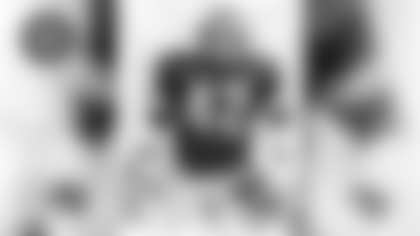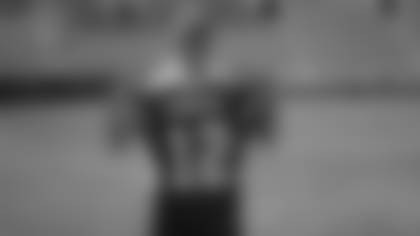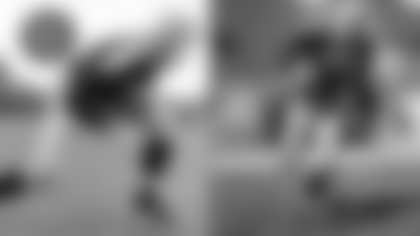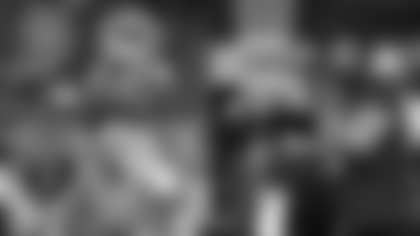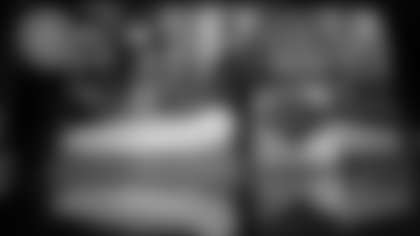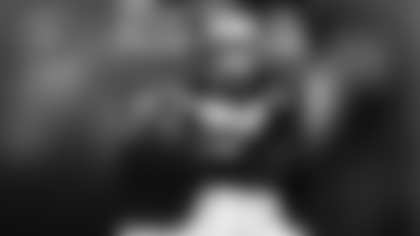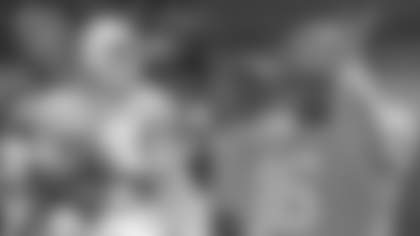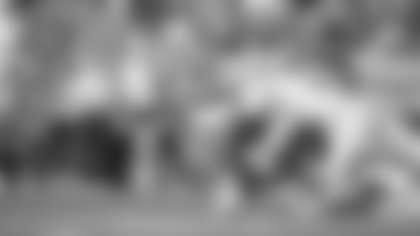Packers team historian Cliff Christl has assembled an oral history series on the NFL Draft, highlighting significant and noteworthy years as a prelude to Green Bay hosting the 2025 draft in late April. New installments will be posted most weekdays. For access to the full series thus far, click here.
1981
The 46th NFL Draft was held April 28-29, 1981, at the Sheraton Hotel in New York City. The first day's proceedings started at 10 a.m. (EDT) and the sixth round ended at 8:41 p.m. The final six rounds started at 10 a.m. the next day and ended at 3:38 p.m. In all, the draft was completed in 16 hours 19 minutes.
It marked the second year that ESPN televised the draft. The number of rounds had been reduced from 17 to 12 in 1977.

Fans can now register for free entry to the 2025 NFL Draft by downloading the NFL OnePass app or by registering online!
Launching Pad to Super Bowl Dominance
Arguably, the 1981 draft reshaped the NFL from a competitive standpoint like maybe no other in history and validated why most football people consider the draft to be the lifeblood of their organizations. Sometimes one draft, even one pick, can change the fortunes of a franchise as was illustrated that year.
Landing Ronnie Lott and rebuilding their secondary helped propel San Francisco to Super Bowl victories at the end of the 1981, '84, '88 and '89 seasons.
By adding three of the original Hogs, as well as fifth-round choice and all-time sack leader Dexter Manley, Washington's bumper crop of rookies served as the launching pad to winning Super Bowls in 1982, '87 and '91.
Lawrence Taylor was the sack leader and superstar of the New York Giants when they won the 1986 and '90 titles. Pre-Taylor, the Giants had suffered through eight straight losing seasons.
Second-round picks Howie Long, by the then Oakland Raiders, and Mike Singletary, by Chicago, were the defensive stalwarts when their teams climaxed the 1983 and '85 seasons, respectively, by winning Super Bowls. Long had a team-high 13 sacks when the Raiders won. Singletary was the Associated Press Defensive Player of the Year when the Bears won.
In summary, the above five teams won 11 consecutive Super Bowls following the 1981 draft, and only the Raiders had won any of the first 15. They won in 1976 and '80.
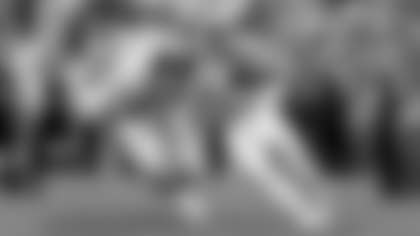
Would it be: Rogers then Taylor or Taylor then Rogers?
In April 1981, a little more than four months after George Rogers (6-2, 230) won the Heisman Trophy at the University of South Carolina, no players were more valued in the NFL Draft than so-called franchise running backs.
Four with that tag had been selected No. 1 in the first 14 common drafts. Even more convincingly, over the previous three drafts, the Houston Oilers had taken Earl Campbell and made the playoffs three straight years following a nine-year drought; while in 1980, the Lions selected Billy Sims and improved from 2-14 to 9-7 in one season.
Thus, Rogers was the odds-on-favorite to go No. 1 to New Orleans. However, linebacker was considered to be the strength of the draft and four would be selected among the top nine choices.
North Carolina's Lawrence Taylor (6-2, 244) was taken second by the Giants; Alabama's E.J. Junior (6-2, 237), fifth by the St. Louis Cardinals; Pittsburgh's Hugh Green (6-1, 219), seventh by Tampa Bay; and Michigan's Mel Owens (6-1, 234), ninth by the Los Angeles Rams through a trade with Washington. Taylor was widely considered the best of the bunch and worthy of consideration for the first pick.
Oilers director of scouting Joe Woolley (Christl interview, April 1981): "The thing I like about Taylor is his attitude. He's just a take-charge guy."
Atlanta director of player personnel Tom Braatz (Christl interview, April 1981): "Lawrence Taylor and Hugh Green are involved in the first four picks. I don't think there have been two linebackers that good in a long time."
New England director of player development Dick Steinberg (Christl interview, April 1981): "(Taylor) is two inches taller, 25 pounds heavier (than Green). That's got to be worth something in a 16-game schedule. Green is as special a defensive player as ever played the college game, but Taylor is just as good an athlete and played pretty consistent."
Tampa Bay director of player personnel Ken Herock (Christl interview, April 1981): "Green, Taylor, Junior—those are three guys who will be in the Pro Bowl for several years."
Green Bay director of player personnel Dick Corrick (Christl interview, April 1981): "Maybe a defensive end. Maybe a middle linebacker in a 4-3 or inside or outside in a 3-4. You take (Taylor), put him where you want him and say, 'Sic 'em.'"
Rogers drew more mixed reviews.
Braatz (Christl interview, April 1981): "He's more like the guy at Tampa (Ricky Bell) out of Southern Cal."
Giants director of player personnel Tom Boisture (Christl interview, April 1981): "Once (Rogers) turns up field, you better hang on to your hat. He's not going to be Campbell, but he's going to be a good back."

How the drama unfolded
With the decision in the hands of the Saints' brain trust, George Young, general manager of the Giants, spent the final days before the draft working the phones at Giants Stadium, eager to learn anything he could through his personal grapevine.
His office was next to that of his third-year head coach, Ray Perkins, and across the hall from the team's draft room. On draft day, Young would await the Saints' choice sitting in a large conference room with no windows and the walls covered with boards listing the prospects. Joining him there would be Perkins, Boisture, assistant general manager Terry Bledsoe and his team of scouts with others coming in and out.
Young (Christl interview, May 1981): "We found out about 11 o'clock that night (before the draft) that the New Orleans guys had called Rogers and told him they were going through with taking him. They had been talking to another team about a trade up until about 10 o'clock that night and we worried about that. Actually, I wasn't sure until the next morning that we were going to get our shot at Taylor. In fact, we wrote Taylor's name on a piece of paper and Rogers' name on a piece of paper. We had found out Taylor was down there (in New Orleans) with the permission of the league for three days before the draft, and we thought New Orleans might have changed its tune. So we sweated that out, too."
John Mara, future president and CEO of the Giants, but then a practicing attorney (Newsday, April 25, 2021): "I remember walking over to the ballroom of the Sheraton in Manhattan and standing at our table waiting for the pick. I remember foolishly hoping we would take George Rogers because we had no running back at the time."
In New Orleans, Bum Phillips had been hired as the Saints' new head coach three months earlier following their 1-15 finish in 1980. Having been the beneficiary of the Campbell pick in his previous post as coach of the Oilers, Phillips leaned running back from the start.
Phillips on taking Rogers (Christl interview, May 1981): "It wasn't tough at all. One guy can do more for you than the other one. We drafted George Rogers because we thought he could do more for our football team than one defensive player could. A right outside backer – the other team can run the other way the whole game. You take George Rogers, and you can let him run the football anywhere you want."
As it turned out, the Saints selected arguably the second-best outside linebacker in the draft in the second round: Rickey Jackson, Green's teammate at Pitt. Jackson (6-1, 224) wasn't Taylor, but he played 15 years and was inducted into the Pro Football Hall of Fame in 2010.
Woolley (Christl interview, April 1981): "The guy who has gotten all the ink is Hugh. But they look like twins. They're about the same size. They both make a lot of plays. Jackson really helped himself in the all-star games."
Washington director of player personnel Mike Allman (Christl interview, April 1981): "You sit up there and turn on the film, and sometimes you get (Jackson) confused with Hugh Green. You don't know which one you're looking at. People started running away from Green and (Jackson) started making all the tackles."
Ken Easley or Ronnie Lott: On the clock all the way to Canton
While six of the top 10 picks were linebackers or running backs, the two other players from that group besides Taylor who made it into Canton were defensive backs: UCLA's Kenny Easley (6-1, 206) and Southern Cal's Lott (6-0, 202). Easley went first on draft day, fourth to Seattle, whereas Lott was chosen eighth by the 49ers. But Lott beat Easley into the Hall of Fame by 17 years. Lott was inducted in 2000; Easley in 2017.
Woolley (Christl interview, April 1981): "I think (Lott) is one of the best I've seen in a long time. I've got him as one of the top three players in the country:"
Braatz (Christl interview, April 1981): "Lott can play the corner. That's why people like him better. Lott is tough and runs a 4.55 and a great athlete. Easley is 4.7 and a strong safety only."
San Francisco coach and GM Bill Walsh (Christl interview, May 1981): "We just never gave Ronnie Lott consideration. We looked at him, but we were positive he would be gone when we drafted. If both had been there, I think we would have taken Ronnie Lott, but we spent much more time with Ken Easley."
Lott was one of four defensive backs drafted by the 49ers in the first five rounds. With him and two other rookie starters in the secondary, they vaulted from 27th out of 28 teams in yards allowed passing in 1980 to third in 1981, en route to winning their first Lombardi Trophy.
Lott started at left cornerback, second-round pick Eric Wright at right cornerback and third-round choice Carlton Williamson at strong safety. In addition, Lynn Thomas, the fifth-round pick, was the 49ers' nickel back for most of the season.
Walsh (Christl interview, January 1982): "We knew we'd get a great one in the first round and, of course, we got Lott. In the second round, we had worked with Wright in the Senior Bowl and had liked him. We thought he was a great corner prospect, who had been a safety (at Missouri). And we had Carlton Williamson rated higher than a lot of teams. The University of Pittsburgh had so much talent that year that he was sort of being overlooked by the scouting combines, and we had gone to Pittsburgh and both (Williamson and Thomas) had run terrific 40 times and were strong, physical athletes. We had 4.5 plus on Williamson and Thomas."
Bart Starr ignores scouts, picks a QB over Lott
The biggest bust of the first round was quarterback Rich Campbell, who was taken sixth by Green Bay, then 13 years into its post-Lombardi tailspin.
First, if the Packers were going to draft 31-year-old Lynn Dickey's heir apparent, they needed to decide who was the better prospect in what was generally perceived as a two-quarterback draft: Campbell from then Pac 10 California or Neil Lomax from NCAA Division I-AA Portland State?
In the eyes of at least some scouts, their skills and numbers were as disparate as their level of competition. Campbell was almost 6-5; Lomax, an inch shorter. As seniors, Lomax threw 37 touchdown passes; Campbell, six, despite a 70 percent completion percentage. Lomax played in a sprint-out offense; Campbell in a traditional drop-back system, where he relied on touch and timing as much as his arm strength.
Walsh at the Senior Bowl, where he was coaching Lomax and the North squad (Christl interview, January 1981): "I think there are mixed feelings on Lomax. None are terribly negative, but some say he is a top prospect, and it won't take long to develop. Others say he is more of a long-range proposition. Every so often, he does something, and you say, 'Wow!' And every so often you say, 'My god.' And that's where he is. But the talent is there."
Braatz (Christl interview, April 1981): "(Lomax) has got a No. 1 arm. He could be better than Phil Simms (drafted by the Giants seventh overall two years earlier out of Morehead State), but he's got a lot of bad habits somebody is going to have to spend a lot of time with. Campbell, if he's well (following late-season MCL surgery), is a franchise type player. He doesn't have the arm of Steve Bartkowski (also from Cal and drafted first overall by the Falcons in 1975), but he moves around better. And they're comparable in every other way."
Allman (Christl interview, April 1981): "(Campbell) is probably as accurate as anybody we've seen for a long time. He's got good height, good field vision. The only negatives on him are mobility a little bit, and he doesn't have quite the big gun. But he has enough arm."
Boisture (Christl interview, April 1981): "(Campbell) didn't play very well when he was healthy. There's nothing really that makes you want to trade to get him. (With Lomax) to take a shot like we did (with Simms), you're going to hit maybe one or two out of five."
Corrick (Christl interview, April 1981): "Everything you see (Lomax) do is play-action and rollouts. You never see him drop and read coverages. (But) the thing that wakes you up is that he has great ability to throw the long ball. Rich is a lot further along being indoctrinated into a pro-style offense. (But) he had a problem last year in that he couldn't get his team in the end zone. His stats were impressive every week, but he wasn't scoring any touchdowns."
As it turned out, the Packers flunked Lomax following a pre-draft physical because of congenital foot and ankle concerns. That eventually narrowed their debate to Campbell, Lott or USC tackle Keith Van Horne as a fallback; and the storyline from there turned into a draft-room soap opera.
Corrick (Christl interview, 1999): "Tom Tipps (Southwest area scout), myself, everybody who looked at (Lott) loved him. Again, Bart sent Ross Fichtner, our secondary coach, out to work him out. For some reason, Lott didn't show up on time. He was like 40 minutes late. Whatever the excuse was, it didn't sell with Ross. Then the kid didn't extend himself during the workout. So Ross developed a personality hang-up with the guy. When Ross came back, he told Bart, 'I can't coach this guy. He's lazy. He's not accountable. I don't want the guy.' So I said to Bart, 'Let's bring (Lott) back and talk to him.'"
Corrick: "We flew Lott and his girlfriend to Green Bay the day before the draft, maybe two. So Bart and (his wife) Cherry, myself and (my wife) Bonnie, and it was going to be Ronnie and his girlfriend. But she stayed back in the hotel. She just wanted to sleep. So the five of us went out to dinner. I think Bart went up to pay the check and Cherry went (somewhere), so Lott was sitting there and told Bonnie, 'You know I always wanted to be a Green Bay Packer. I've always admired coach Starr. It would be a dream for me to come here.'"
Corrick: "Hell, everything through the meal, everything that was said was very positive for why we should take this guy. I thought that I had sealed the deal. Then the morning of the draft, Bart walks into my office, shuts the door and said, 'I can't take Ronnie Lott.' I said, 'Why not?' 'Ross says he doesn't want him and I'm not going to take a guy our position coach doesn't feel good about.'"
Fichtner (Christl interview, 2000): "They've always blamed me for not wanting him. It has been handed down through the years, but it's absolutely not true. Anyway, I had some friends who came with me (to Lott's tryout) who were not part of the ball team. They were just standing around. Ronnie Lott was the only guy who worked out of maybe 100 guys in my four years with the Packers who gave me absolutely no effort. I mean he didn't do anything. Meantime, Lott said to one of the guys who were with me. 'Boy, I hope they don't draft me because I'm not going to Green Bay.' When I got back to Green Bay, I told Bart and Dick Corrick, 'You may want to consider that.'"
Corrick (Christl interview, 1999): "(Campbell) hurt his (non-throwing) arm and that was a major concern. We noticed he didn't have a conventional throwing motion. But Zeke (Bratkowski, offensive backfield coach and former NFL quarterback) went out to work the guy out and for some reason liked him."
Bob Harlan, future Packers president and then assistant to the president, on the Campbell pick (Christl interview, 2005): "I was sitting next to Lloyd Eaton (in the draft room). He was sitting on my right and he says to me, 'That's a bad choice.' I said, 'Why?' He says, 'He can't play.' I said, 'What do you mean he can't play? You're the West Coast scout, why don't you say something?' He said, 'They don't listen to me.'"
Steinberg on Lomax lasting until the second round after being named MVP of the Senior Bowl (Christl interview, May 1981): "I can't figure that out. He impressed us (at the Senior Bowl). He was coming off a poor performance in the East-West Shrine Game – not a poor performance maybe, but not a real impressive one – and to me (the Senior Bowl) was a showcase. He got down there and he really took control of that game. He hit the open receiver. He didn't force the ball. He showed great poise. We had him as a first-round pick."
Lomax, on his pre-draft visit to Green Bay and then being selected in the second round by the St. Louis Cardinals and starting a playoff game against the Packers in his second season (Christl interview, January 1983): "I remember vividly my trip to Green Bay and meeting my longtime idol, Bart Starr. What a thrill it was to meet him and his wife. It was me, Keith Van Horne and Freeman McNeil, who went up there together. They had a quarterback coach at that time named Zeke Bratkowski, and he told me they needed help at quarterback. He also told me they were not going to take me in the first round. He said if they took a quarterback, I'd be the one. But not in the first round."
Starr (Christl interview, 1986): "Here was a quarterback, of all things. I should be able to judge a quarterback, and I knew (Campbell) couldn't play, and I allowed myself to be talked into it."
Lomax was the Cardinals' starter for eight years and made two Pro Bowls. Campbell appeared in seven games and attempted only 68 passes in his four years with the Packers.
In the end, on Oct. 26, 1986, it was Lott who got in the last word after he scored the go-ahead touchdown on a 55-yard interception return as the 49ers coasted to a 31-17 victory over the Packers at Milwaukee County Stadium.
Lott (Christl interview, Oct. 26, 1986): "I remember I flew up there two days before the draft. Coach Starr was there and (linebackers) coach (John) Marshall, who had been my coach at USC. I had a feeling I was coming there. But they took Rich Campbell and had a lot of success with Rich."
San Francisco, Washington win Super Bowls off Packers mistakes
There's an adage among NFL personnel people that "teams draft off other team's mistakes." And that's precisely what San Francisco and Washington did in 1981. Thanks in part to the Packers, they positioned themselves to win seven of the next 11 Super Bowls.
The 49ers already had capitalized on a Packers mistake two years earlier when they drafted Notre Dame's Joe Montana in the third round. Despite the draft-room pleas of their Midwest scout Red Cochran, the Packers passed on Montana twice to take future busts Steve Atkins and Charlie Johnson.
When Lott fell to them, the 49ers acquired the cornerstone of their defense for their four Super Bowl titles in the 1980s.
Washington's 1981 haul included three future starters for its offensive line, the strength of its three Super Bowl champs. It drafted Mark May (6-5, 300) in the first round, and he started for most of his nine seasons there at right guard or right tackle. Third-round pick Russ Grimm started at left guard and was inducted into the Hall of Fame in 2010. Joe Jacoby was a 6-7, 305-pound rookie free agent out of Louisville who started at left tackle in three Super Bowls.
Washington coveted Grimm enough to relinquish a first-round pick in 1982 for the 13th choice in the third round, plus two fifth-round selections. Seven spots before Washington drafted Grimm, the Packers selected punter Ray Stachowicz. Despite their personnel director writing a glowing report on Grimm, Green Bay's coaching staff wasn't sold on him.
Corrick (Christl interview, pre-1981 draft): "(Grimm's) got great hand use. He's got good balance. He's stout. He's a little bit of a man-made player. He came there (the University of Pittsburgh) as a quarterback at 195 pounds, and he has built up to 262, 265. I like his temperament."
Corrick on why the Packers then passed on Grimm to draft a punter who was cut after two seasons (Christl interview, circa 1980s): "That's where getting different people involved ends up hurting you. I thought we had a feel for him that was unbelievable."
Washington general manager Bobby Beathard (Christl interview, 1982): "I went up there two days and watched (May and Grimm) practice and said, 'That guy (Grimm) is a No. 1 draft choice.' I never did waver on that, and I sent our offensive line coach up there, and he loved him, too. You knew May was rated there. From what we could find out, nobody had Grimm rated that well. … So when we thought there was a chance to get him in the third round, we had to do something because we were getting a No. 1 draft choice in our opinion. He was a guy who could come in and start and be all-pro."
Beathard, on signing Jacoby immediately after the draft (Christl interview, 1982): "Here's a guy we still weren't that impressed with other than size. If we had liked him, we would have drafted him. What I didn't know was that he would develop the way he did. Joe Bugel is a great offensive line coach, and he just worked with the guy and it is amazing what happened. He's a real high IQ kid, and he's got unusual strength. What we didn't know is that he could move his feet and do the things he can do now. I don't know why we couldn't see it. The coaches (at Louisville) can't believe it."
Second-round steals: Singletary & Long
Considering Singletary (5-11, 227) fell short of the height standard for NFL middle linebackers and Long (6-5, 261) played at Villanova, a school that would drop football after 87 years less than two weeks before the draft, some scouts held reservations about both players.
But the Bears traded up one spot in front of Minnesota to grab Singletary with the 10th pick of the second round. The Raiders took Long, their left defensive end for 13 seasons, with the 20th selection.
That was 21 picks after Philadelphia, home of Villanova, drafted University of Houston defensive end Leonard Mitchell (6-6, 283). In six years with the Eagles, Mitchell recorded one sack, 90½ fewer than Long had for the Raiders.
Denver assistant general manager Carroll Hardy (Christl interview, April 1981): "(Singletary) has one problem and that's his height. A good big man is better than a good little man any day in the game of football."
Corrick (Christl interview, April 1981): "(Singletary) singlehandedly made Baylor a champion. He's the best little player in America. He's a fine college player, but God, a 5-11 middle linebacker. At his height, he has to be moving and guessing because he can't follow the ball."
Woolley (Christl interview, April 1981): "(Long's) coming up because he's a great effort player."
Ron Wolf, future Green Bay general manager and then head of player personnel operations for the Raiders (Christl interview, 2022): "I saw Howie Long and he was a really good player. (Playing at Villanova) did not give the Raiders any pause whatsoever in drafting him because of his athleticism and overall ability. In my 25 years with the Raiders, he was one of the two best players in my opinion."
Corrick on Mitchell (Christl interview, April 1981): "That guy is all man. This guy has everything. You just have to find the button to make him go. I think he's been on vacation for two years."
Philadelphia director of player personnel Carl Peterson (Philadelphia Daily News, April 29, 1981): "We had Mitchell rated so high, we didn't dream he'd be available (at No. 27). Either a lot of people made a mistake, or we did."
Philadelphia head coach Dick Vermeil (Philadelphia Daily News, April 29, 1981): "We had (Mitchell) rated the No. 1 defensive end and the seventh best player in the United States."




